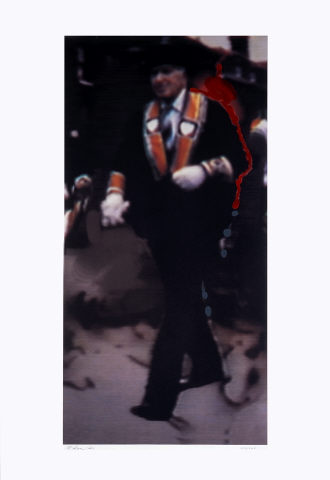
- 1990
- Paper
- Lithography
- Inv. 98GE600
Richard Hamilton
The Orangeman
Often investigating appearances and perception in relation to political issues, Richard Hamilton’s The Orangeman is a part of a suite of works that engage with ‘The Troubles’ in Northern Ireland. This constitutional conflict is between the Unionist Protestants who want to retain British rule and the Republican Catholics who desire to join the neighbouring Republic of Ireland. One of the players in this conflict remains the Protestant brotherhood commonly referred to as the Orange Order, a conservative organisation that swears to protect Protestant dominion and superiority.
Hamilton’s The Orangeman appropriates media footage of an Orange Order member in uniform, complete with a distinctive orange sash. Manipulating the image using the computer program Quantel Paintbox, Hamilton then applied a red streak to the hazy work. This red mark chaotically follows the curve of the figure’s back, rupturing the surface of the image and clashing with the orange in the uniform. Orange Order marches, predominately through Catholic neighbourhoods, often erupted in violence. The red mark could be viewed as visually suggesting the disruption following this man, or, as Hamilton has isolated this figure, the red could reflect the officer’s position as a walking target.
Never fully disclosing a clear opinion within The Orangeman, Hamilton’s motive is to instead analyse the role of television in bringing war, protest and conflict reportage to the public. Via reworking media footage that invites distant matters into one’s home, essentially allowing outsiders to become invested, the artist opens captured moments up for multiple readings. Hamilton’s work considers questions regarding the mass media’s role in myth making, the easy distortion of political imagery to serve a particular agenda and how understandings of the past can be easily altered. These ideas relate to a wider concern in Hamilton’s politicised works, examining how collective memories can be shaped through mediated experiences.
Olivia Welch
| Type | Value | Unit | Section |
| Width | 70 | cm | |
| Height | 85 | cm | |
| Width | 42,5 | cm | |
| Height | 100 | cm |
| Type | Acquisition |
| 1/150 Gravar e Multiplicar |
| Almada, Casa da Cerca - Centro de Arte Contemporânea, 2009 |
| ISBN:9789728794583 |
| Catálogo de exposição |
| 1/150 Gravar e Multiplicar - Gravuras da Colecção do Centro de Arte Moderna da Fundação Calouste Gulbenkian |
| Casa da Cerca - Centro de Arte Contemporânea |
| Curator: Casa da Cerca - Centro de Arte Contemporânea |
| 31 de Janeiro de 2009 a 17 de Maio de 2009 Casa da Cerca |
| exposição comissariada por Ana Vasconcelos, Emília Ferreira e António Canau (Comissário científico). |